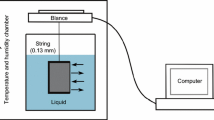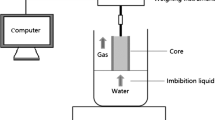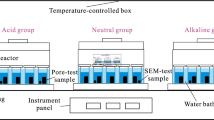Abstract
A shale gas reservoir is commonly characterized by nano-scale pores and throats, high clay contents, and strong heterogeneity in permeability and porosity. Such tight structure can prevent a large proportion of fracturing fluid from flowing back after the hydraulic fracturing operations. It remains challenging to quantitatively analyze the water imbibition capability of shale as the rock sample size and shape are not unified when water imbibition behavior is experimentally investigated. In this study, a new method is proposed to evaluate the water imbibition capability of shale using the ratio of the imbibition area to the mass of the rock sample to normalize the size and shape of the sample. More specifically, the experimental shale samples were collected from three different shale gas reservoirs (Sichuan Changning Block, Yunnan Zhaotong Block, Chongqing Pengshui Block) to verify the proposed method and evaluate the influencing factors of shale imbibition capability. Imbibition experiments were then conducted to analyze the influence of four factors, including matrix porosity, fracture size, clay, and rock sample size, on the water imbibition capability of shale. The results show that the proposed method can characterize the maximum imbibition capability and imbibition rate and avoid errors in the measured porosity. In addition, the rank of factors affecting the imbibition capability was found to be fracture size, porosity, clay content, and sample size.











Similar content being viewed by others
References
Chen M, Bai J, Kang Y (2021a) Redistribution of fracturing fluid in shales and its impact on gas transport capacity. J Nat Gas Sci Eng 86:103747
Chen M, Li P, Kang Y, Zhou X, You L, Zhang X, Bai L (2021b) Effect of aqueous phase trapping in shale matrix on methane sorption and diffusion capacity. Fuel 289:119967
Cheng Y (2012) Impact of water dynamics in fractures on the performance of hydraulically fractured wells in gas shale reservoirs. J Can Pet Technol 51(2):143–151
Dehghanpour H, Lan Q, Saeed Y (2013) Spontaneous imbibition of brine and oil in gas shales: effect of water adsorption and resulting micro fractures. Energy Fuels 27(6):3039–3049
Ding Y, Yu X, Liu X (2021) Novel analytical model of shale spontaneous imbibition considering the hydration effect. Energy Fuels 35(22):18518–18532
Eveline VF, Akkutlu IY (2018) Osmosis and clay swelling effects in gas shale formations under stress. SPE Annual Technical Conference and Exhibition, Society of Petroleum Engineers, Dallas. SPE-191599-MS. https://doi.org/10.2118/191599-MS
Gao H, Zhugeng B, Wang C (2021) Effects of pore structure and salinity on the imbibition of shale samples using physical simulation and NMR technique: a case from Chang 7 shale, Ordos Basin. Simulation 97(2):167–173
Handy LL (1960) Determination of effective capillary pressures for porous media from imbibition data. Transactions of the AIME 219(01):75–80. https://doi.org/10.2118/1361-G
Li C, Singh H, Cai J (2019) Spontaneous imbibition in shale: a review of recent advances. Capillarity 2(2):17–32. https://doi.org/10.26804/capi.2019.02.01
Liu Z, Bai B, Wang Y, Qu H, Xiao Q, Zeng S (2021) Spontaneous imbibition characteristics of slickwater and its components in Longmaxi shale. J Petrol Sci Eng 202:108599
Makhanov K (2013) An experimental study of spontaneous imbibition in horn river shales. University of Alberta, Edmonton, Alberta
Mattax C, Kyete JR (1962) Imbibition oil recovery from fractured, water-drive reservoir. SPE J 2:177–184
Meng M, Ge H, Ji W (2015) Investigation on the variation of shale permeability with spontaneous imbibition time: sandstones and volcanic rocks as comparative study. J Nat Gas Sci Eng 27:1546–1554
Olafuyi OA, Cinar Y, Knackstedt MA (2007) Spontaneous imbibition in small cores. Proceedings of Asia Pacific Oil and Gas Conference and Exhibition. https://doi.org/10.2523/109724-ms
Ren K (2016) 湖南页岩气藏吸水能力及其对输送能力的影响. Doctoral dissertation, China University of Petroleum (Beijing)
Roshan H, Ehsani S, Marjo CE (2015) Mechanisms of water adsorption into partially saturated fractured shales: an experimental study. Fuel 159:628–637
Sheng M, Tian S, Cheng Z (2019) Insights into the influence of fluid imbibition on dynamic mechanics of tight shale. J Petrol Sci Eng 173:1031–1036
Yan Q, Lemanski C, Karpyn ZT (2015) Experimental investigation of shale gas production impairment due to fracturing fluid migration during shut-in time. J Nat Gas Sci Eng 24(12):99–105
Yang F, Zheng H, Guo Q (2021) Modeling water imbibition and penetration in shales: new insights into the retention of fracturing fluids. Energy Fuels 35(17):13776–13787
Zhou F, Chen W (2009) Experimental study of low permeability core imbibition. Complex Oil Gas Reservoirs 2(1):54–56
Zhou Z, Abass H, Li X (2016) Experimental investigation of the effect of imbibition on shale permeability during hydraulic fracturing. J Nat Gas Sci Eng 29:413–430
Zhou Y, You L, Jia C (2022) Influencing factors and application of spontaneous imbibition of fracturing fluids in lacustrine and marine shale gas reservoir. Energy Fuels 36(7):3606–3618
Funding
This work is supported by the National Natural Science Foundation of China (No. 42272176) and the China Postdoctoral Science Foundation (2022M722636).
Author information
Authors and Affiliations
Contributions
All authors contributed to the study concept and design. Experimental material preparation, data collection, and analysis were performed by Ying Li, Maomao Li, Haitao Li, and Shengnan Chen. The first draft of the manuscript was written by Ying Li, text checking and proofreading were performed by Shu Long, and all authors commented on previous versions of the manuscript. All authors read and approved the final manuscript.
Corresponding authors
Ethics declarations
Conflict of interest
The authors declare no competing interests.
Additional information
Responsible Editor: Santanu Banerjee
Rights and permissions
Springer Nature or its licensor (e.g. a society or other partner) holds exclusive rights to this article under a publishing agreement with the author(s) or other rightsholder(s); author self-archiving of the accepted manuscript version of this article is solely governed by the terms of such publishing agreement and applicable law.
About this article
Cite this article
Li, Y., Li, M., Li, H. et al. Investigation of shale imbibition capability and the influencing factors based on a convenient method. Arab J Geosci 16, 65 (2023). https://doi.org/10.1007/s12517-022-11137-8
Received:
Accepted:
Published:
DOI: https://doi.org/10.1007/s12517-022-11137-8




